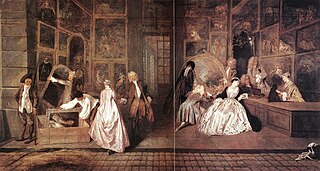
L'Enseigne de Gersaint is an oil on canvas painting in the Charlottenburg Palace in Berlin, by French painter Jean-Antoine Watteau. Completed during 1720–21, it is considered to be the last prominent work of Watteau, who died some time after. It was painted as a shop sign for the marchand-mercier, or art dealer, Edme François Gersaint. According to Daniel Roche the sign functioned more as an advertisement for the artist than the dealer.

Actors of the Comédie-Française, also traditionally known as The Coquettes, is an oil on panel painting in the Hermitage Museum, Saint Petersburg, by the French Rococo artist Antoine Watteau (1684–1721). Variously dated within the 1710s by scholars, the painting forms a compact half-length composition that combines portraiture and genre painting, notably influenced by Venetian school, the Le Nain brothers, and Watteau's master Claude Gillot; one of the rarest cases in Watteau's body of work, it shows five figures — two women, two men, and a black boy — amid a darkened background, in contrary to landscapes that are usually found in Watteau's fêtes galantes.

The Shepherds is a c. 1717 painting by Antoine Watteau, now in the Schloss Charlottenburg in Berlin. It is the most finished version of a composition later reused by the same artist in Pastoral Pleasure.
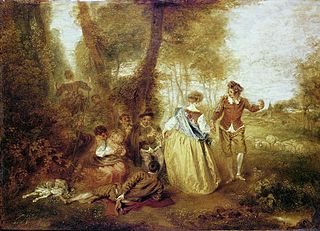
Pastoral Pleasure is a c. 1714–1716 fête galante painting by Antoine Watteau, now in the Musée Condé in Chantilly. Two other Watteau paintings survive with extremely similar compositions - the largest and most finished is The Shepherds, now in the Charlottenburg Palace, Berlin; another painting of that composition, once owned by Georges Wildenstein, seems to be a reworking of the Charlottenburg painting. Pierre Rosenberg argues that the Chantilly painting was an oil sketch for the Charlottenburg one. Three other copies of the Chantilly version appeared in 19th and 20th century auctions, but their locations are now unknown.
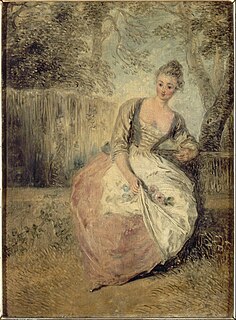
The Worried Lover is an oil on panel painting in the Musée Condé, Chantilly, by the French Rococo artist Antoine Watteau. Variously dated to c. 1715–1720, the painting was among private collections throughout the 18th and 19th centuries, until it has been acquired by Henri d'Orleans, Duke of Aumale, son of King Louis Philippe I; as part of the Duke of Aumale's collection at the Château de Chantilly, The Worried Lover was bequeathed to the Institut de France in 1884.
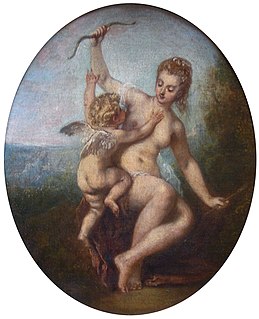
Cupid Disarmed is a c. 1715 painting, usually but not definitively attributed to Antoine Watteau. It is one of eight paintings kept by Watteau's friend and protector Jean de Jullienne until the latter's death in 1766. Benoît Audran engraved it in 1727 and described and reproduced it in an inventory of the Jullienne collection in 1756. After Jullienne's death the art dealer Boileau bought it for Jean-Baptiste de Montullé, Jullienne's executor.

The Chord, alternatively known as The Serenader and Mezzetino, is an oil on panel painting in the Musée Condé, Chantilly, by the French Rococo painter Antoine Watteau, variously dated c. 1714–1717. Throughout the 18th and 19th centuries, The Chord passed through numerous private collections, until it came into possession of Henri d'Orléans, Duke of Aumale, son of King Louis Philippe I; as part of the Duke of Aumale's collection at the Château de Chantilly, The Chord was bequeathed to the Institut de France in 1884.
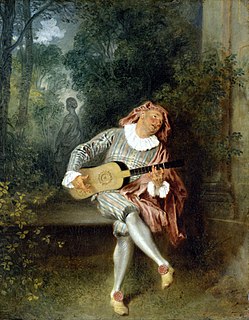
Mezzetino is an oil on canvas painting in the Metropolitan Museum of Art, New York, by the French Rococo painter Jean-Antoine Watteau. Dated within 1717–1720, Mezzetino forms a full-length single-figure composition, depicting the eponymous character in commedia dell'arte. In the 18th century, Mezzetino was owned by Jean de Jullienne, the friend and patron of Watteau who supervised the four-volume edition of prints after the artist's works, for which the picture was engraved by Benoit Audran the Elder; after Jullienne's death in 1766, it was acquired for the Hermitage in Saint Petersburg, then recently established by Empress Catherine II of Russia. During the Soviet sales in the 1920s and 1930s, Mezzetino was sold to British-American businessman Calouste Gulbenkian; it was later sold to the Wildenstein art firm in Paris and New York, from which it was bought in 1934 by the Metropolitan Museum of Art, where it remains; the institution also owns a preparatory study—a drawing of the man's head.

The Perfect Accord, also adapted into English as Perfect Harmony, is a oil on panel painting by Antoine Watteau, created c. 1719, now held in the Los Angeles County Museum of Art. It was the pendant to the same artist's The Surprise.

The Surprise is an oil on panel painting by the French Rococo artist Antoine Watteau, created c. 1718, now held in the J. Paul Getty Museum, in Los Angeles. The painting depicts showing a male guitarist, dressed as Mezzetino, watching an embracing couple embrace, with a small dog watching the whole scene; it notably exhibits Watteau's use of recurrent figures, as well as the influence of Flemish Baroque painting on his art.

The Two Cousins is a 1716 oil on canvas painting by Antoine Watteau, now in the Louvre Museum, in Paris, which acquired it in 1990.

Pierrot, also retrospectively known as Gilles, is an oil on canvas painting of c. 1718-1719 by the French Rococo artist Jean-Antoine Watteau (1684–1721). Completed in the later phase of Watteau's career, Pierrot measures 184.5 by 149.5 cm, which makes up somewhat unusual case in the artist's body of work. The painting depicts a number of actors portraying commedia dell'arte masks, with one as the titular character set in the foreground.

The Embarrassing Proposal is a 1715-1716 painting by Antoine Watteau. It was part of Heinrich von Brühl's collection in Dresden before being purchased in 1769 under Catherine II of Russia for the Hermitage Museum, in Saint Petersburg, where it still hangs.

Marriage Contract and Country Dancing is a c. 1711 painting by Antoine Watteau. It entered the Spanish royal collection as part of the collection of Isabella Farnese and was recorded in the La Granja de San Ildefonso Palace in Segovia. It is now in the Prado Museum, in Madrid. It shows the signing of a marriage contract in a rural landscape.

Fêtes Vénitiennes is a 1719 painting by Antoine Watteau, now in the Scottish National Gallery in Edinburgh, to which it was bequeathed in 1861 by Lady Murray of Henderland, widow of John Murray, Lord Murray. It takes its title from a 1732 engraving of the work by Laurent Cars and is derived from the Venetian styles of dress and dancing shown in the work, the former inspired by the commedia dell'arte. It belongs to the fêtes galantes genre created by Watteau.

La Boudeuse is the modern title given to an oil on canvas painting in the Hermitage Museum, Saint Petersburg, by the French Rococo painter Antoine Watteau (1684–1721). Completed in the late 1710s, La Boudeuse depicts a young couple set amidst a park in the foreground, in a rare example of the two-figure landscape composition which is considered one of the best fêtes galantes in Watteau's later work. However, the picture's authenticity was also a subject of scholarly debate, for it had been engraved by English painter Philippe Mercier, once a follower of Watteau, and was not included in Jean de Jullienne's edition of Watteau's work published in the 1730s.
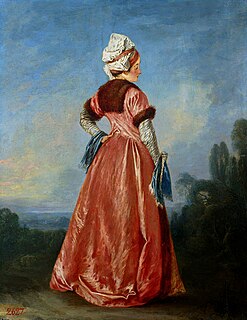
Polish Woman is an oil on panel painting in the National Museum, Warsaw, historically attributed to the French Rococo artist Jean-Antoine Watteau. The painting correlates to a presumably lost drawing by Watteau that is now known via François Boucher's etching published in 1726 as part of the Recueil Jullienne. Given that the painting is not signed, its attribution and dating remains uncertain; various authors either accept or reject the painting as a Watteau, dating it from the early 1710s to the early 1730s.
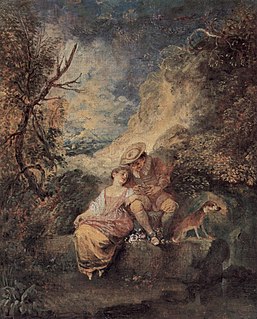
The Robber of the Sparrow's Nest is an oil painting by the French Rococo artist Antoine Watteau, now in the National Galleries of Scotland, Edinburgh. Variously dated between 1709 and 1716, the painting is a pastoral scene that is one of a few extant arabesques in Watteau's art; it shows a young couple with a dog, sitting at a sparrow's nest; it has been thought to be influenced by Flemish Baroque painting, exactly by Peter Paul Rubens' painting from the Marie de' Medici cycle.
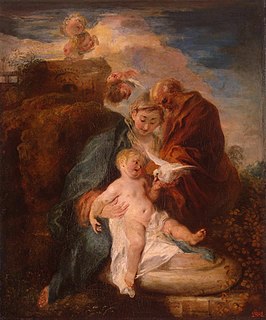
Holy Family, also called The Rest on the Flight into Egypt, is an oil on canvas painting by the French Rococo artist Antoine Watteau, now in the Hermitage Museum, Saint Petersburg. Variously dated between 1714 and 1721, Holy Family is possibly the rarest surviving religious subject in Watteau's art, related to either the Gospel of Matthew, or the Gospel of Pseudo-Matthew; it depicts the Virgin, the Christ Child, and Saint Joseph amid a landscape, surrounded by putti.

The Dreamer is an oil on panel painting of c. 1712–1717 in the Art Institute, Chicago, by the French Rococo artist Antoine Watteau. The painting is a single-figure, full-length composition that shows a seated young woman amid a landscape, dressed in somewhat an exotic attire consisting of long red gown with fur garment and white bonnet; it is a recurring subject that is also present in numerous paintings and drawings by Watteau such as The Coquettes, dit Actors of the Comédie-Française. There were attempts to identify the sitter of the painting, who was notably thought to be Watteau's contemporary, the Comédie-Française actress Charlotte Desmares.




















